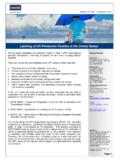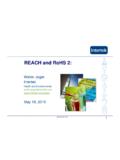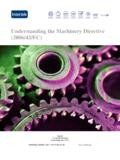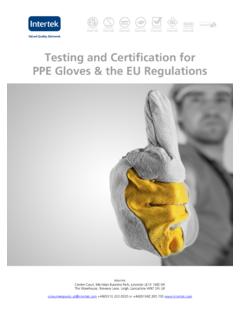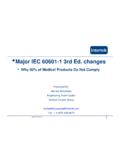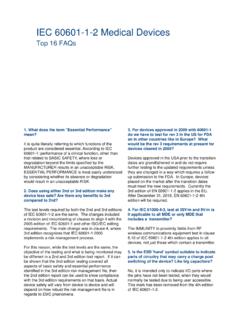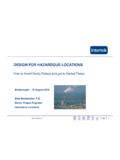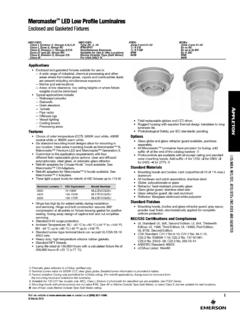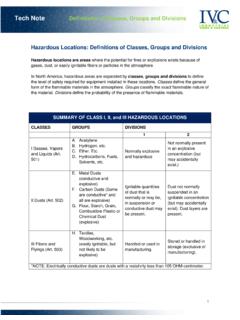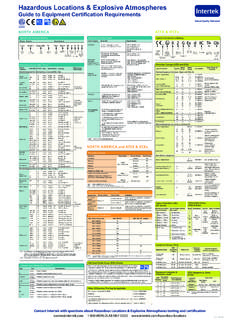Transcription of Hazardous Locations Overview - Intertek
1 Hazardous Locations Overview Presented By: Ryan Parks Hazardous Locations Team Leader Topics of Discussion What is a Hazardous Location? What causes an explosion? Potential ignition sources Protection concepts 101. Classification Schemes (ATEX/IEC vs. NEC). Designing/Certification for HazLoc Hazardous Locations Overview , Ignitions Sources, and Protection Concepts What is Potentially Explosive Atmosphere Certification and why might you need it? Any industry that processes, uses or manufactures materials that may give rise to a flammable atmosphere (gas, mist, liquid, dusts or even small fibres) may have a potentially explosive atmosphere.
2 Such industries/processes include: Oil and Gas Drilling Petrochemical Refining and Processing Fuel Storage Chemical manufacturing Car Manufacturing Water Treatment Power Generation Pharmaceutical Distilleries Food manufacturers Aviation Military Painting Deepwater Horizon Facts about Disaster 11 Missing, presumed dead $350,000,000 cost for rig (now 5,000 ft below water). $350,000,000 spent so far BP. 200,000 gallons (5,000 barrels) leaking per day in the Gulf - $75/barrell = $375,000/day $2 14 billion estimated in clean-up and compensation (preliminary). Damage to shipping lanes, tourism, fishing/shrimping industry, and wildlife/environment Faulty cement casing around well; failed pressure testing hours before explosion Faulty BOP; Kill Switch not activated What is an explosion?
3 In order to create an explosion there has to be fuel (for example and explosive gas such as hydrogen), and oxidizer (such as the oxygen in air) and a source of ignition energy (for example, a hot surface or an electrical spark). These three items are commonly referred to as the fire triangle'. The Fuel The explosion properties of our fuel (gasses, vapours, combustible dusts) have been studied and organized by their fammability limits and ignition temp etc. in order to suitably assess the potential of an explosion and to take appropriate preventative measures to avoid an explosion. Fuel Properties All flammable gasses, vapours and mists require to be mixed with oxygen to make them burn.
4 There is about 20-21% of oxygen in the air we breath. Mixtures of a flammable gas and certain percentages of air will burn if ignited. Too much or too little oxygen, the mixture will not ignite. The upper and lower concentrations of gas in atmospheric air, by volume, are known as their flammability or explosive limit. Explosion Properties Lower Explosive Limit (LEL). The concentration of flammable gas or vapour in air, below which the gas atmosphere is not explosive. Upper Explosive Limit (UEL). The concentration of flammable gas or vapour in air, above which the gas atmosphere is not explosive.
5 Explosion Properties Examples of Explosive Limits Substance LEL (%) UEL (%). Methane 5 15. Propane 2 Ethylene 34. Acetylene 3 100. Hydrogen 4 Explosion Properties At a critical concentration called the most easily ignited concentration (MEIC), the amount of energy required to cause ignition is minimal. The critical energy at the MEIC is called minimum ignition energy (MIE). Fuel Properties Temperature Every material has a spontaneous ignition temperature, SIT. (or AIT, auto ignition temperature) at which it will ignite spontaneously. If the temperature of a mixture is raised, the amount of electrical energy required for ignition will decrease, reaching zero at the AIT.
6 Temperature classification Equipment is identified with a temperature class Either identified by a T' rating or by a temperature in degrees C. The temperature class identifies the hottest temperature that the equipment can obtain. This can be a either the inside or the outside of the equipment depending on the protection concept. Temperature Class The full list of temperature codes are Temperature Class The resulting temperature codes for the substances listed previously (temperature classification) are shown below: Substance Temp Class Methane T1. Propane T1. Ethylene T2. Acetylene T2. Hydrogen T1.
7 Gas Grouping Example: Material Flashpoint LEL UEL Ignition Temp T Gas (deg C) (%) (%) (deg C) Class Group Methane -188 537 T1 IIA. Ammonia NA 15 630 T1 IIA. Kerosene 38 210 T3 IIA. Combustible Dust Around 50 explosions are reported per year, ranging from small deflagrations to building destroying detonations which lead to large numbers of fatalities. They are usually associated with the grain and mining industries, however they can occur whenever a process uses particulate materials, either as feed stocks, intermediates or products. Potential Ignition Sources Hot surfaces Flames Mechanically generated sparks Stray electric currents Static Lightening Radio Frequency (Range 1 & 2).
8 Ionising Radiation Ultrasonic Adiabatic compression and shock waves Exothermic reactions (inc. self ignition of dusts). Protection Concepts ATEX, IEC and NEC 505 use the same protection concepts. NEC 500 only uses Ex d, Ex i, DIV 2 and Purge. Only intrinsic safety is very similar. European Equipment must meet Constructional Requirements & Tests. Flameproof (Explosion-proof) Ex d It is assumed that the surrounding explosive atmosphere can enter the enclosure and that there will be internal explosions during the life of the equipment. The enclosure therefore has to be strong enough not to fracture or distort under the internal pressures generated.
9 Contains explosions and prevents propagation Applications: Switchgear, motors, lights Flamepath Intrinsic Safety Low energy levels prevents incendive sparking and hotspots Purged and Pressurized Excludes gas by positive pressure differential 3 types: Static, leakage compensation and continuous dilution Applications: Control cabinets, analyser units and analytical instruments Increased Safety Ex e The apparatus must not arc, spark, or produce ignition capable hot surfaces in normal operation. X X X. OIL IMMERSIONN Ex o Steel Vessel Oil Electrical Apparatus POWDER FILLING Ex q Protection of high power electronics Applications: starters for Ex e lighting, capacitors etc Electrical Apparatus Powder Filling Enclosure Encapsulation Protects by immersion in encapsulant Typical applications: Solenoid valves, power supplies Encapsulation Ex m'.
10 Cable Entry Encapsulant Electrical Apparatus Explosive Atmosphere Type n' Protection for Zone 2. Methods: Non sparking/arcing parts Sealed or encapsulated device Restricted breathing Enclosed break Simplified pressurization Hermetically sealed Encapsulated Energy limiting apparatus Protection Concept for Dust Classified Areas The protection concept for dust hazards is to prevent the dust from entering the enclosure or apparatus. Additionally, the maximum surface temperature of the equipment to which the dust can be exposed shall not exceed the ignition temperature of the dust. The IP (Ingress Protection) rating system provides a means of classifying the degree of protection from foreign bodies and liquids.


